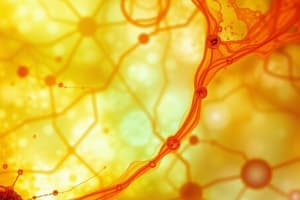Podcast
Questions and Answers
¿Cuál es el principio fundamental detrás de la técnica de cromatografía?
¿Cuál es el principio fundamental detrás de la técnica de cromatografía?
- La reacción química entre los componentes de la mezcla.
- La solubilidad diferencial de las sustancias en las fases estacionaria y móvil. (correct)
- El tamaño de las partículas de los componentes de la mezcla.
- La diferencia en los puntos de ebullición de los componentes de la mezcla.
¿Qué tipo de cromatografía se emplea cuando las fases son sólido-líquido?
¿Qué tipo de cromatografía se emplea cuando las fases son sólido-líquido?
- Cromatografía en columna, en papel y en capa fina. (correct)
- Cromatografía de gases.
- Cromatografía de líquidos.
- Cromatografía de adsorción.
¿Qué representa el Rf en cromatografía?
¿Qué representa el Rf en cromatografía?
- La cantidad de fase estacionaria utilizada.
- La relación de frentes, calculada dividiendo la distancia recorrida por el componente entre la distancia recorrida por el solvente. (correct)
- La distancia total recorrida por el solvente.
- La velocidad de migración del solvente.
¿Qué se debe hacer si los componentes de una mezcla separados por cromatografía son incoloros?
¿Qué se debe hacer si los componentes de una mezcla separados por cromatografía son incoloros?
¿Cuál es la fase estacionaria en la cromatografía en capa fina (TLC)?
¿Cuál es la fase estacionaria en la cromatografía en capa fina (TLC)?
¿Qué propiedad del eluente es crucial para que ascienda por capilaridad en la TLC?
¿Qué propiedad del eluente es crucial para que ascienda por capilaridad en la TLC?
¿Cuál es uno de los objetivos principales al aplicar la muestra en la placa cromatográfica?
¿Cuál es uno de los objetivos principales al aplicar la muestra en la placa cromatográfica?
¿Qué precaución principal se debe tomar al colocar la placa en la cuba cromatográfica?
¿Qué precaución principal se debe tomar al colocar la placa en la cuba cromatográfica?
¿Qué se entiende por el proceso de destilación?
¿Qué se entiende por el proceso de destilación?
¿Qué representa la presión de vapor de un líquido?
¿Qué representa la presión de vapor de un líquido?
Según la ley de Raoult, ¿cómo se relaciona la presión total de vapor de una mezcla?
Según la ley de Raoult, ¿cómo se relaciona la presión total de vapor de una mezcla?
¿En qué tipo de muestras es particularmente útil la destilación a presión reducida?
¿En qué tipo de muestras es particularmente útil la destilación a presión reducida?
¿Cuál es el criterio principal para seleccionar la destilación simple como método de separación?
¿Cuál es el criterio principal para seleccionar la destilación simple como método de separación?
¿Qué ventaja ofrece la destilación fraccionada en comparación con la destilación simple?
¿Qué ventaja ofrece la destilación fraccionada en comparación con la destilación simple?
¿Cuál es el propósito de la columna de fraccionamiento en la destilación fraccionada?
¿Cuál es el propósito de la columna de fraccionamiento en la destilación fraccionada?
¿Qué tipo de sustancias se separan mediante la destilación por arrastre con vapor?
¿Qué tipo de sustancias se separan mediante la destilación por arrastre con vapor?
¿Cómo afecta la inmiscibilidad de los líquidos en la destilación por arrastre con vapor al proceso?
¿Cómo afecta la inmiscibilidad de los líquidos en la destilación por arrastre con vapor al proceso?
¿Qué ley física describe el comportamiento de mezclas de líquidos no miscibles durante la destilación?
¿Qué ley física describe el comportamiento de mezclas de líquidos no miscibles durante la destilación?
¿Qué ventaja principal ofrece la destilación por arrastre con vapor para compuestos con altos puntos de ebullición?
¿Qué ventaja principal ofrece la destilación por arrastre con vapor para compuestos con altos puntos de ebullición?
Flashcards
¿Qué es la cromatografía?
¿Qué es la cromatografía?
Técnica para separar mezclas de compuestos orgánicos basada en la distribución entre una fase estacionaria y una móvil.
¿Qué es la cromatografía en capa fina (TLC)?
¿Qué es la cromatografía en capa fina (TLC)?
Cromatografía donde las fases son sólido y líquido.
¿Qué es el Rf (Relación de frentes)?
¿Qué es el Rf (Relación de frentes)?
Relación entre la distancia recorrida por el analito y la distancia recorrida por el eluyente en cromatografía.
¿Qué es la destilación?
¿Qué es la destilación?
Signup and view all the flashcards
¿Qué es la presión de vapor?
¿Qué es la presión de vapor?
Signup and view all the flashcards
¿Cuándo es útil la destilación simple?
¿Cuándo es útil la destilación simple?
Signup and view all the flashcards
¿Cuándo es útil la destilación fraccionada?
¿Cuándo es útil la destilación fraccionada?
Signup and view all the flashcards
¿En qué consiste la destilación por arrastre con vapor?
¿En qué consiste la destilación por arrastre con vapor?
Signup and view all the flashcards
¿Qué es la ley de Raoult?
¿Qué es la ley de Raoult?
Signup and view all the flashcards
Study Notes
Cromatografía
- Cromatografía is used to separate mixtures of organic compounds, defined as the separation of a mixture of two or more different compounds via distribution between a stationary and a mobile phase.
- Types of chromatography depend on the nature of the two phases.
- When the two phases are solid-liquid, it is column, paper, or thin layer chromatography.
- When the phases are liquid-liquid, it is liquid chromatography.
- When the phases are gas-liquid, it is gas chromatography.
- All chromatographies work on the same principle as extraction, depending on the differential solubility of the substances to be separated with respect to the two phases.
- There is a physical constant known as Rf (relation of fronts) that can be calculated by dividing the distance the original mixture travelled by the distance the compound travelled.
Cromatografía en Capa Fina (TLC)
- Thin layer chromatography is an adsorption chromatography of the solid-liquid type, where the stationary phase is an adsorbent placed on glass or plastic and the mobile phase is a solvent or mixture
- The most used adsorbents are alumina G (aluminum oxide) and silica gel G (silicic acid SiO2).
- In this technique, the eluent ascends through the plate by capillarity according to its affinity and solubility.
- The advantage of this technique is its speed and low cost.
Experimental Procedure for TLC
- A line should be marked with pencil 1 cm away from the base of the plate.
- Place a small drop of the sample to analyze with a microcapillary, let it dry completely and add a second drop in the same place.
- The drop´s diameter must not exceed 2mm.
- Place 2 to 3 ml of eluent (Butanol-Acetic Acid-Water 12:3:5) inside an appropiate container (chromatographic tank) and cover it.
- Place the plate inside the container, making sure that the applied sample does not touch the eluent.
- Do not move the container is to guarantee adequate capilarity to a hight of approximately 3mm from the top of the plate.
- Retire the plate and immediately mark the eluent front with a pencil.
- Let it dry inside a fume hood with an air dryer to accelerate and proceed to determine the Rf of each compound marking the eluent´s front.
Destilación
- Destilation is when a liquid converts to vapor phase and is then condensed and recollected.
- Vapor pressure is the pressure exerted by the vapor that is in equilibrium with the liquid at a given temperature.
Destilación Simple
- Simple distillation is useful for separating mixtures whose boiling points differ by 70°C or more.
- When the boiling points differ by less than 70°C, fractional distillation is used.
- Simple distillation can be used to distill a pure component, such as the separation of ethyl alcohol from an alcoholic beverage.
Destilación Fraccionada
- Fractional distillation is useful for separating mixtures that have boiling point differences of less than 70°C.
- Fractional distillation involves two components, each exerting its vapor pressure.
- A fractionating column is used to lengthen the path between the distillation flask and the condenser.
- The column allows for multiple vaporization and condensation cycles, equivalent to several small distillations.
- Each vaporization-condensation cycle is equivalent to a simple distillation
- The more cycles, the more the vapor is enriched in the more volatile component, and the condensate is less volatile, leading to a more effective separation.
Destilación por Arrastre con Vapor
- Steam distillation is used to separate organic substances that are insoluble in water and slightly volatile from non-volatile substances in a mixture like resins or inorganic salts.
- When there are mixtures of liquids that are not miscible, distillation follows Dalton's law regarding partial pressures.
- During steam distillation, the combined vapor pressures of the water and the component to be separated equals atmospheric pressure, initiating distillation.
- The condensed vapor phase results in a mixture of two phases: aqueous and organic components.
- Compounds with high boiling points can be distilled using an immiscible liquid, like extracting compounds or essential oils.
- Steam distillation can be used for compounds with high boiling points that decompose near their boiling points using water at a sufficiently low temperature to prevent decomposition.
Studying That Suits You
Use AI to generate personalized quizzes and flashcards to suit your learning preferences.




